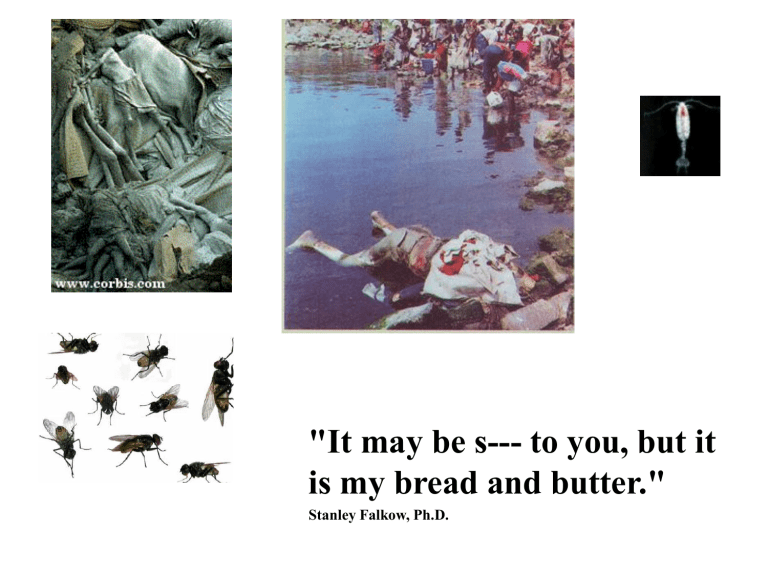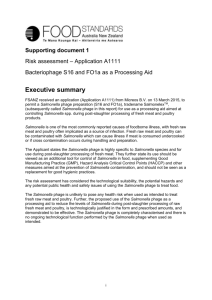March 12 lecture presentation

"It may be s--- to you, but it is my bread and butter."
Stanley Falkow, Ph.D.
Genetics of Pathogens
• Life styles of pathogen
• Methods to identify genes needed for virulence
• Environmental signals for virulence gene regulation
• Specific Examples
The Main Points of
Pathogenesis
• The pathogens are usually one step ahead
• The host is one step behind
• Why are we not all dead?
• We are not all dead nor are all pathogens eliminated?
Bacteria do not have brains and they do not seek you out.
The purpose of a bacterium is to make bacteria.
Life does not exist in pure culture.
Life does not exist in logarithmic growth-stationary phase and hungry is the usual state
• Sometimes, the bacteria/virus makes mistakes-too virulent.
Influence pandemic-HIV?
• Sometimes, the bacteria/virus is not virulent enough.
Robert Koch (1876)
• Koch's postulates
– find microorganism in all cases of the disease, that are absent in healthy animals
– isolate the microorganism from diseased host in pure culture
– infect a healthy animal with the microorganism and get the same disease
– Isolate the same microorganism in pure culture from the infected host
Molecular Koch’s Postulates
.
• The phenotype or property under investigation should be associated with pathogenic members of a genus or pathogenic species.
• Specific inactivation of the gene(s) associated with the suspected virulence trait should lead to a measurable loss in pathogenicity or virulence.
• Reversion of the mutated gene should lead to restoration of pathogenicity: complementation.
•
Current molecular pathogenesis research is held to this standard.
It is not always possible to satisfy the third rule for technical or physiological reasons.
Pathogen classes: Barriers to genetics?
Extra-cellular +/- toxin
E.coli
Staphylococcus
Streptococcus
Facultative Intracellular
Listeria
Salmonella
Shigella
Mycobacterium TB
Obligate Intracellular
Chlamyidia
Rickettsia
Mycobacterium leprae
E.coli easy
Staph-Strep more difficult
Easy!
No genetics
Facultative intracellular: can live inside host cells and outside
Obligate intracellular: can live only inside host cells
Extracellular: lives on the surface of the host.
Regulation of cholera toxin production in Vibrio cholerae
cholera toxin produced at 37 °C, physiologic salt 150mM, amino acids, slightly basic pH: basically conditions that would exist in the small intesting
-ToxR-ToxS produced at 25-30 °C, acid pH
An example of temporal and spatial regulation of regulatory molecules
Cholera toxin is encoded on a phage, called CT
-regulation of phage expression is also controlled by the
SOS pathway.
Cholerae toxin is encoded on a prophage and is mobile
Cholerae Toxin
Expression of the prophage genes and toxin is controlled by the SOS pathway
Induction of SOS causes induction of the entire phage and cholerae toxin production. LexA is cleaved, the RstR repressor protein comes off, and the phage gene expression is induced.
Repression mechanism is similar to lambda phage cII system.
QuickTime™ and a
decompressor are needed to see this picture.
QuickTime™ and a
decompressor are needed to see this picture.
QuickTime™ and a
decompressor are needed to see this picture.
Shiga toxin is enocode on a lambda-like phage. Production of shiga toxin is controlled by a similar system in lambda phage.
Conditions that induce the phage also induce the production of toxin.
Shiga toxin is encoded on a phage, H-19B
E.coli O157:H7 “hamburger E.coli” HUS in humans
-production of Shiga toxin regulated, condition that mimic bowel
-Antibiotic treatment of people with HUS is lethal!
-Antibiotic can induce the phage and also lyse cells filled with toxin
1.
Mark phage with Km
2.
Treat cells with DNA damage agent mitomycin C
3.
Harvest culture supernatants
4.
Determine titer and transduce Amp marker
Results: DNA damaging agents induced the phage and toxin production!
Mechanism for horizontal gene transfer
Brute force method
STM: Signature Tagged Mutagenesis
QuickTime™ and a
decompressor are needed to see this picture.
QuickTime™ and a
decompressor are needed to see this picture.
IVET: In vivo expression technology
QuickTime™ and a
decompressor are needed to see this picture.
Results of a lot of mutant hunts
1.
Pathogens contain genes not found in their closely related counter parts
2.
Genes specific to the pathogens are organized into islands, islet, atolls.
That is, specific regions that are unique to the pathogens.
3.
Pathogenicity islands encode those functions needed for the pathogen to causes a successful infection. It still needs the rest of the chromosome!
4.
Pathogenicity islands have different G+C content than the backbone chromosome. Islands tend to be A+T rich, especially in Salmonella and
E.coli.
5.
PA’s can encode a specialized secretion apparatus designed to transfer effector proteins into the host. The proteins are specifically designed to alter host cell function. The proteins usually interact with a specific host protein or class of proteins.
6.
Some but not all PA’s have inserted in a rare tRNA seltRNA. This insertion event does not interrupt the tRNA, but provides a powerful selection for the PA’s presence.
General structure of a genomic island.
-in pathogens, called PA: Pathogenicity Island
-usually PAs are inserted into rare tRNA, selenocysteine tRNA
-tRNA is sometime duplicated and still functional or a new one is carried on the incoming island
-this provides a selection to hold the island in place
Chromosomal Location of Salmonella Pathogenicity Islands
Spi-4 Macrophage Survival?
Spi-3 Macrophage Survival
0
Spi-5 Unknown
Salmonella Chromosome
4.910
6 Bases
Spi-1 Invasion Spi-2 Macrophage Survival
50
Virulence Plasmid
120kb
The secretion apparatus may be an old flagella or phage?
QuickTime™ and a
TIFF (LZW) decompressor are needed to see this picture.
Salmonella Pathogenesis - INTRODUCTION
• Salmonella is an enteric pathogen capable of infecting a wide variety of vertebrate hosts
• Not all infected hosts exhibit clinical symptoms of
Salmonella infection
• Non-typhoidal Salmonella serotypes cause enteritis and occasional systemic infection
• Certain Salmonella serovars exhibit host adaptation but the mechanisms are poorly understood
• Salmonella is a facultative intracellular pathogen adapted to survival in host mononuclear phagocytes
• Genetic tools are available to dissect virtually every aspect of the Salmonella-host interaction
Great Moments in Salmonella History
1.
First isolated by Theobald Smith. S . Choleraesuis from porcine intestine around 1885. He worked for Daniel Salmon, who had nothing to do with the work.
2.
1829- P.Ch.A. Louis in Paris separated typhoid from other fevers.
3.
1884-Gaffkey Germany isolated Salmonella Typhi from spleens of infected patients
4.
1896- first heat killed vaccine by Pfeiffer and Kalle.
5.
1920 to 1940-Kaufman and White developed the serotype classification of
Salmonella
6.
1952-Zinder and Lederberg-discovered genetic transduction using phage
P22
7.
1973Bruce Ames developed the “Ames Test” to determine mutagenic activity of chemicals
8.
September 1984Salmonella Typhimurium used to restaurants in the The
Dalles, OR.
“Typhoid Mary” was Mary Mallon
Major Differences between S.
Typhi and S.
Typhimurium
Salmonella Typhi
Host adapted: humans
Systemic Infection resulting in
Enteric fever with little diarrhea
Vaccine available
Carrier state
Salmonella Typhimurium
Non-host adapted
Rarely extra-intestinal but usually the cause of diarrhea
No vaccine available
No long-term carrier state
Properties of SlyA
1.
slyA is found in many Gram-negative bacteria, both pathogenic and and non-pathogenic
2.
The sequence is conserved
3.
SlyA has been classified in the MarR family of small molecular weight transcriptional regulatory proteins
4.
SlyA mutants of Salmonella are profoundly attenuated for virulence
5.
SlyA mutants are unable to survive and replicate in host macrophages
6.
Originally thought to be a toxin, but later discovered not to be.
PhoP
The PhoP and SlyA Regulons
Overlap
SlyA
nanA
Flagella
Spi-1 mgtBC phoN phoP pmrD sodCI mig-5 envE mig-14 pagC pagD pagK pagJ pgtE ugtL virK ycbY ydhJ ydhI yggM yhcN ssrAB nmpC
STM1249
STM1328
STM1498/1499 marA
PhoP/PhoQ in Salmonella
PhoP/PhoQ two component regulatory system
1.
Was identified in the first gene hunt for Salmonella vir genes
2.
Is needed for virulence
3.
Transmits the signal from the host to the bacteria for survival inside epithelial cells, phagocytes, and in the lumen of intestine
Possible mechanisms by which PhoP and SlyA coordinately control Transcription of target genes:
PhoP regulates the transcription of slyA directly.
NO
PhoP and SlyA interact together at target loci.
Not formally excluded, but probably not
PhoP controls post translational modification of SlyA or the production of a ligand needed for SlyA activity.
Focus of current research
QuickTime™ and a
decompressor are needed to see this picture.
QuickTime™ and a
decompressor are needed to see this picture.
QuickTime™ and a
decompressor are needed to see this picture.
QuickTime™ and a
decompressor are needed to see this picture.
QuickTime™ and a
decompressor are needed to see this picture.
QuickTime™ and a
decompressor are needed to see this picture.
SlyA
The end




